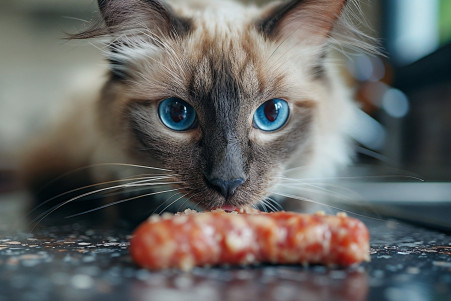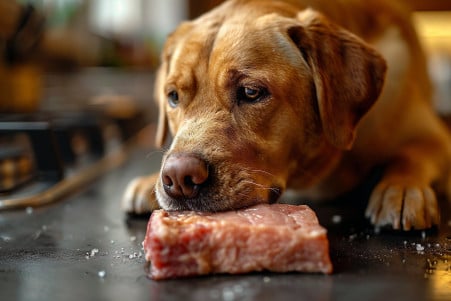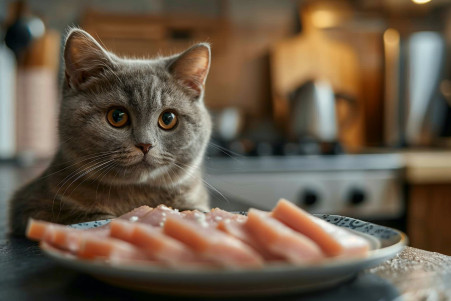Can Cats Eat Pork? Safe Feeding Practices for Feline Diets
26 February 2024 • Updated 26 February 2024

Whether or not cats can eat pork safely is yet another mystery surrounding these enigmatic animals. While cats can eat pork, it needs to be cooked to kill parasites and should be fed in moderation because it’s high in fat and sodium.
To avoid health problems, don’t feed cats pork that’s been seasoned and don’t give them pork bones. If you’re looking for information about how to feed your cat pork, you should talk to your vet.
This article will go over the scientific research and nutritional studies that help us understand what cats need in their diets. We’ll also cover what vets have learned about the dangers and benefits of feeding cats pork, how easy it is for cats to digest different kinds of meat, and how much and what kind of pork cats can eat.
Throughout, we’ll focus on the evidence-based research that supports the best ways to feed cats pork, and we won’t be influenced by any particular companies or products.
Can cats eat pork?
Understanding Feline Nutrition: Is Pork Safe for Cats to Eat?
Cats are obligate carnivores, which means that they have a biological need for a diet that is made up mostly of high-quality animal protein. According to the Cornell University College of Veterinary Medicine, cats need a variety of nutrients, including amino acids, fatty acids, vitamins, and minerals, and these nutrients are most easily found in animal products.
Pork can be a good addition to a cat’s diet because it’s full of B vitamins and essential amino acids, both of which are important for cats.
That said, pork is also high in fat and sodium, both of which can be harmful to cats if they’re consumed in large amounts. According to VCA Animal Hospitals, a cat’s balanced diet should not be thrown off by an overabundance of any one kind of meat, including pork.
To make sure that your cat’s diet stays balanced, pork should be fed in moderation and in a way that meets the cat’s nutritional needs without leading to weight gain or nutritional deficiencies.
Veterinary experts recommend that treats, including pork, make up no more than 10–15% of a cat’s daily caloric intake. When feeding pork to your cat, it should be lean, fully cooked, and unseasoned to avoid adding extra fat and sodium. By feeding pork in small, controlled amounts on an occasional basis, you can make sure that it’s safe for your cat to eat and that it supports their overall health and well-being.
Risks and Benefits of Pork in Your Cat’s Diet
While pork can be a good source of nutrition for your cat, there are also some risks associated with it if it’s not prepared properly. One of the most well-known risks is trichinosis, a parasitic disease that can be caused by eating undercooked pork. The CDC says that you can prevent this infection by cooking pork to an internal temperature that will kill Trichinella larvae.
In addition to these safety concerns, there are also some nutritional benefits to feeding your cat pork. Pork is a good source of taurine, an essential amino acid that’s important for feline eye and heart health, according to PetMD.
Cats can’t make enough taurine on their own, so they have to get it from their diet, and meat is one of the best sources. Taurine deficiencies can cause a number of health problems, including central retinal degeneration and dilated cardiomyopathy.
When it comes to feeding your cat pork, it’s important to weigh these risks and benefits. If you take the proper safety precautions, you can ensure that your cat gets the nutritional benefits of pork, including taurine, while avoiding the risk of parasitic infections.
However, while pork is a good option, it’s also important to make sure that your cat is getting a variety of proteins. While pork can be used in rotation with other meats, such as fish and chicken, which are more commonly found in commercial cat food, it’s best to make sure that pork is just one of several proteins in your cat’s diet to ensure that it’s well-rounded and nutritious.
Pork Byproducts in Cat Food
When it comes to commercial cat food, it can be hard to know exactly what you’re feeding your cat, especially when it comes to byproducts.
According to Spruce Pets, byproducts are often stigmatized as low-quality ingredients that are used as fillers.
In reality, byproducts are organ meats like liver and kidneys that are full of nutrients. These ingredients can be a great source of protein, vitamins, and minerals, all of which are important for a cat’s diet.
Vital Essentials also points out the nutritional benefits of pork, including the fact that it’s full of essential amino acids, including taurine and thiamine, which are both important for a cat’s health.
According to PetMD, the USDA is responsible for regulating and inspecting animal byproducts in cat food to make sure they are safe for cats to eat.
However, it’s still important to make sure you’re reading labels carefully when you’re choosing a commercial cat food that includes pork byproducts.
That said, if you’re buying from reputable manufacturers, pork byproducts can be an important part of your cat’s diet. After all, focusing on high-quality ingredients is in line with a cat’s natural digestive system and will help ensure your cat is getting the nutrition they need to be healthy and happy.
Cat Digestive Physiology and Pork Digestibility
The cat digestive system is highly specialized to process a meat-based diet. Cats have a very acidic stomach that is designed to efficiently break down animal proteins, and their digestive tracts are shorter than those of omnivores, which is an evolutionary result of their status as obligate carnivores.
According to a report from Washington State University, this specialization extends to the digestive system, which includes the mouth, esophagus, stomach, intestines, pancreas, liver, and gallbladder, all of which are designed to extract the most nutrients from meat.
In terms of digestibility, including pork, cats use this highly efficient system to extract the nutrients they need. However, pork has a higher fat content than other meats like chicken or fish, so its digestibility may be impacted and it should be introduced to your cat’s diet with caution.
A study published in PMC by James L. Weemhoff found that cats digest protein more efficiently than dogs, but that digestibility can be impacted by dietary fiber and protein sources.
To help your cat digest pork, make sure it is cooked thoroughly and fed in moderation. Purina notes that a meat-based diet should include optimal levels of high-quality protein.
When adding pork to your cat’s diet, do so slowly and in small amounts to make sure your cat can tolerate it and that it doesn’t cause any digestive upset. Keep in mind that good nutrition is important for your cat’s health, and pork can be part of a healthy diet if you follow your vet’s advice and use evidence-based methods.
Conclusion: What to Know About Cats and Pork
As we’ve covered in this article, pork can be a part of your cat’s diet if it’s fed in the right way. Both Cooper Pet Care and Catster stress the importance of feeding pork in moderation and making sure it’s prepared safely—It is important to cook pork thoroughly to get rid of parasites and bacteria, and to make sure that it is boneless and free of seasonings.
Lean pork can be a good source of protein and important nutrients like B vitamins, which help with a cat’s nervous and immune systems, and digestion.
That said, pork’s high fat and sodium content means it shouldn’t replace other leaner protein sources, like chicken or fish, in a cat’s diet. Not only do these other options help reduce the risk of weight gain and obesity, but they also better meet a cat’s nutritional needs.
So while pork can be a healthy addition to your cat’s diet, it’s important to make sure you’re following the rules for safe consumption. Always talk to your vet before introducing new foods to make sure they’re right for your cat’s individual dietary needs. And don’t forget that a diverse, well-rounded diet that’s tailored to your cat’s specific needs is the best way to make sure they’re healthy and happy.


